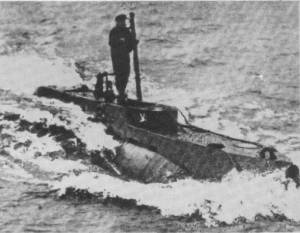- Author
- Hudspeth, K.R., LCDR, RANR Rtd
- Subjects
- WWII operations
- Tags
-
- RAN Ships
- None noted.
- Publication
- September 1994 edition of the Naval Historical Review (all rights reserved)
X20 was towed by trawler from Spithead to a point near the mine barrier, where she was cast off late at night. On diesel engine she crossed the barrier at her 6 knots and at daylight dived, heading for the coast at economical motor speed of 2 knots. To reach the destination precisely, at this speed and in the strong cross-tides of the Baie de Seine, was a measure of Willmott’s remarkable navigational skill.
Coming to periscope depth for a look at one time, we found ourselves surrounded by small French fishing boats under sail, trolling in a glassy sea, but we escaped detection. Not long afterwards we suspected that we were passing below another fleet when the deck-periscope –and the side scuttles revealed scattered white patches which we momentarily thought were pieces of white toilet paper. Close inspection revealed an extensive shoal of translucent jellyfish.
Then for three afternoons, on the rising tide, we moved inshore at periscope depth till we touched sand, recording the bottom profile by echo-sounder and recording periscope observation of beaches, sea-walls, buildings, fortifications, access and other details. These examinations covered the area which became Omaha Beach, to be attacked by U.S. forces. On two afternoons we were startled by sudden eruptions of that underwater pinging sound made by bullets or small shells, going on for some minutes. We hastily withdrew the periscope, went astern and scuttled for deeper water, waiting for the arrival of E-boats – but nothing happened. We never found what it was about.
For two nights, after withdrawing offshore we surfaced and anchored and our two soldiers, in rubber swimming suits and equipped with a mass of measuring, recording, signalling equipment and arms, swam to shore and crawled about the beaches, dodging sentries, before swimming out again, signalling to be picked up. They were the heroes of the operation and their story deserves fuller telling.
While at anchor we charged batteries and at daylight each morning sank to the bottom to rest before the afternoon recce. After the third day we headed on the surface, in fresh conditions, for the Isle of Wight, to rendezvous with the waiting trawler next afternoon.
Operation Gambit – June 2-6 1944

We were disappointed that no more similar operations were permitted, but were assured that we were to have a role in Operation Neptune for which we practised assiduously, including participation in a full-scale landing exercise at Slapton Sands, near Start Point in Devon. En route, heading in misty weather for Portland, X20 was inadvertently led by its escort into the edge of the Portland Race. It was a highly exhilarating experience standing on the open deck with two feet of freeboard as she rolled nearly to her beam ends and those below were quite worried. It was the only moment of real danger I suffered in X-Craft.
In early summer the build-up in Portsmouth and all southern England became increasingly obvious and we were always on stand-by. Even so, it was an uncomfortable secret to carry when I was told the projected D-Day some time in advance.
Our role was to cross the Channel in advance of the invasion and to act as markers to assist the navigational craft leading the first columns of landing craft. X20 was to operate off Juno Beach (Courseuilles) and X23 Sword Beach. None of us played chess and we were not wholly reassured when we looked up the dictionary explanation of our code name GAMBIT(!)
The originally intended D-Day was 5 June and we sailed with trawler escort on the evening of the 2nd. This time we spent a full day submerged before surfacing for a night dash across the minefield, to reach our billets off the French coast in the morning. Navigation this time was by LCDR Paul Clarke RN, who had replaced Willmott. The normal X-Craft crew, including its ERA accompanied two COPP officers.
Till dark we lay on the bottom, resting, eating and countering condensation. At dark we surfaced and anchored, to listen for a radio message coded into the 11 p.m. BBC news. It came – the invasion was postponed: we were astonished, for conditions were very moderate.
So batteries were charged and the boat ventilated and at daylight we sank for another 18 hours waiting through the 5th. This time the BBC message told us it was on – in spite of rising wind and sea.




